Fish & Wildlife
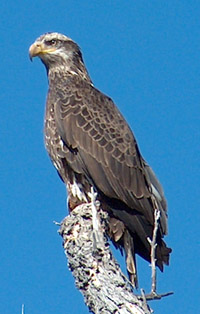 Birds
Birds
More than 348 bird species have been sighted along the Bill Williams River (BWR), including resident, wintering, summer breeding and migratory taxa. The BWR attracts bird watchers from around the world and has been designated an Important Bird Area by the Audubon Society and a Globally Important Bird Area by the American Bird Conservancy.
Riparian ecosystems, and particularly the BWR corridor, provide critical resources such as water, vegetation, and abundant food for resident, wintering, summer breeding and migrating birds, in the xeric environment of the southwestern United States (Grinnell 1914, Rosenberg et al. 1991). Riparian habitat comprises less than 1% of the landscape in the southwest, yet supports more migrating and breeding birds than all other western habitat types combined, with half of the breeding species being riparian obligates (Knopf 1988, Anderson and Ohmart 1977, Johnson et al. 1977). Riparian habitat also serves as critical stop-over habitat for neotropical migratory birds, supporting https://platacard.mx/es/ 10 times more birds than surrounding uplands during migration (Stevens et al. 1977). Aspects of the life history and habitat relationships of many southwestern birds are tied to both floristic composition and structural characteristics of the riparian plant community.
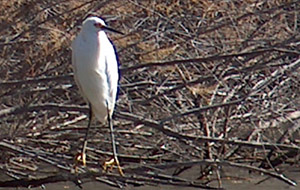 Many bird species of concern inhabit the Bill Williams River corridor. For example, the Sonoran Yellow Warbler, Bell's Vireo, Summer Tanager, and Yellow-breasted Chat were quite abundant breeding species on the Lower Colorado River until the 1950's, when their breeding populations began a decades-long decline resulting in their near elimination (Rosenberg et al. 1991). All four of these species have now recolonized the Bill Williams River since the early 1990's following floods and the regeneration of the dense riparian habitat they require. Today, they have become among the most common breeding species on the refuge (Kathleen Blair, personal observation). Other riparian species have reached levels of federal concern, including the Southwestern Willow Flycatcher, Yuma Clapper Rail (which are Federally endangered) and the Yellow-Billed Cuckoo (which was recently designated a candidate species for protection.)
Many bird species of concern inhabit the Bill Williams River corridor. For example, the Sonoran Yellow Warbler, Bell's Vireo, Summer Tanager, and Yellow-breasted Chat were quite abundant breeding species on the Lower Colorado River until the 1950's, when their breeding populations began a decades-long decline resulting in their near elimination (Rosenberg et al. 1991). All four of these species have now recolonized the Bill Williams River since the early 1990's following floods and the regeneration of the dense riparian habitat they require. Today, they have become among the most common breeding species on the refuge (Kathleen Blair, personal observation). Other riparian species have reached levels of federal concern, including the Southwestern Willow Flycatcher, Yuma Clapper Rail (which are Federally endangered) and the Yellow-Billed Cuckoo (which was recently designated a candidate species for protection.)
Other species of particular interest that use the riparian corridor are, the Bald Eagle, and Peregrine Falcon. The BWR, Alamo Lake, and the adjacent vegetation provide important nesting, roosting, and foraging habitat for each of these species. Further, these habitats are important for supporting game bird species such as Gambel’s Quail and the Mourning Dove.
Aquatic Organisms
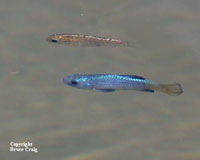 A number of organisms such as fish and aquatic insects live some or all of their life within the river water. Different aquatic habitats support different species. Some of the key differences in habitats include the degree to which water is flowing, the water depth, and the proportion of the year that water is present. Examples of different aquatic habitats in the BWR include lentic, or standing water, types such as beaver ponds, in-channel pools, off-channel pools, as well as Alamo Lake and Lake Havasu (downstream of the Bill Williams River.) Flowing water, or lotic, habitats include in-channel stretches of flowing water or outflows from beaver dams.
A number of organisms such as fish and aquatic insects live some or all of their life within the river water. Different aquatic habitats support different species. Some of the key differences in habitats include the degree to which water is flowing, the water depth, and the proportion of the year that water is present. Examples of different aquatic habitats in the BWR include lentic, or standing water, types such as beaver ponds, in-channel pools, off-channel pools, as well as Alamo Lake and Lake Havasu (downstream of the Bill Williams River.) Flowing water, or lotic, habitats include in-channel stretches of flowing water or outflows from beaver dams.
Benthic macroinvertebrates were surveyed qualitatively around 1980 (USFWS 1981) and quantitatively during the 1990's (BLM 1993; Vinson 1994, 1995, 1996, 1999). Most of these surveys targeted lotic riffle habitats, and thus do not characterize the macroinvertebrate communities in lentic beaver pond habitats. The BWR aquatic invertebrate fauna is typical of low-elevation Arizona rivers that possess unstable (non-bedrock) benthic substrates. Mayflies such as Baetis can be extremely abundant where suitable flowing-water riffles are present, reaching densities above 10,000 per m2 (10.8 f2 or 925 per f2)at some sites (Vinson 1999). Other taxa that reach high abundances locally include the micro-caddisfly Hydroptila, the baetid mayfly Acentrella, and chironomid fly larvae. Various dragonflies and damselflies are also relatively common along the BWR, both of which are often viewed by ecologists as indicators of healthy systems.
The fish fauna in the BWR above Alamo Dam is currently dominated by non-native and sport fish species including largemouth bass, channel catfish, black crappie, bluegill sunfish, green sunfish, and red shiner (USFWS 1992), with similar species composition below the dam, although, often in much lower densities. Non-native mosquitofish are found throughout the BWR drainage (USFWS 1992) and are abundant in beaver dam ponds below Alamo Dam (M. T. Bogan, pers. observation 2004). Historically, the native endangered razorback sucker may have used the lowest reaches of the Bill Williams River during periods of sustained high flows (C. Minckley, pers. communication 2004), but reduced flows on the BWR and reduced razorback populations in the mainstem Colorado River have prevented this in recent decades. The native longfin dace occurred throughout the BWR and its tributaries as late as the early 1990's (USFWS 1992), but currently it is rare below Alamo Dam.
Other Animals
The animals that use the floodplain and associated lotic and lentic aquatic habitats of the BWR can be classified as either facultatively or obligately riparian (e.g., see Andersen et al. 2000). Facultatively riparian species may use the riparian zone extensively, but individuals can also survive and reproduce using only upland habitats. Thus, the maintenance of their populations is not strictly dependent upon the presence of the habitats associated with a riverine ecosystem. Obligately riparian species are those whose life cycle requires resources or habitats provided only by the riparian (here, riverine riparian) environment. Even obligately riparian species may be found outside the riparian zone under particular circumstances, however (for example, while dispersing).
The riverine ecosystem created by flows in the Bill Williams River contains a large number of aquatic, semi-aquatic, and terrestrial animals that range in size from microarthropods associated with decomposing detritus to large mammals, both herbivores and predators, that use the riverine corridor as a source of food, shelter, and water. These organisms form a complex trophic web that ties together not only the various components of the riverine ecosystem (e.g., the stream, parafluvial zone, and vegetated floodplain), but also the riverine ecosystem to the surrounding desert.
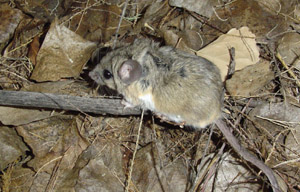 |
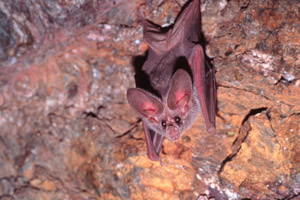 |
Some of the critters present along the BWR corridor include large herbivores, such as mule deer and desert bighorn sheep, javelina (peccaries) and perhaps even elk. Beaver are an especially prevalent and important animal occupying the BWR. In between flood events, beaver have built dozens of dams along the river, influencing the river geomorphology, surface and groundwater dynamics, riparian vegetation and the animals using these habitats. Other animals along the river include small mammals such the Bailey's Pocket Mouse, Canyon Mouse, Merriam's Kangaroo Rat, Southern Grasshopper Mouse, Arizona Cotton Rat, and the White-throated Wood Rat. At least 14 bat species occur along the BWR, many of which specialize in consuming the night-flying, nocturnal, insects of the riparian zones such as mosquitoes and mayflies just as many of the birds specialize in the day-active, diurnal insects. Mammalian predators that hunt for prey within the BWR include mountain lions, bobcats, ringtail cats and grey and kit foxes.
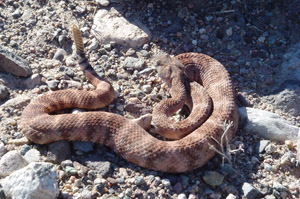 |
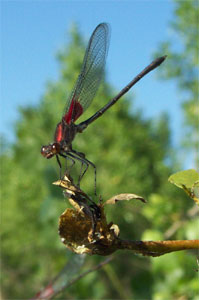 |
Typical of desert regions, the BWR hosts a large number of different reptile and amphibian species. Of particular note is the Lowland Leopard Frog that has largely been lost throughout most (if not all) of the rest of the lower Colorado River, possibly due in part to the introduction of Bullfrogs and Crawfish. It has been proposed that the absence of Bullfrogs on the Bill Williams is due to the fact of the system's continued flood regime.
Finally, insect life is abundant along the river, including the apache cicada, which feeds on the roots of floodplain trees. Also, thirty eight butterfly species have been found on the refuge, several of which were extremely common 50-100 years ago but now are quite rare or absent throughout most of the rest of the Lower Colorado River. This is both because of the loss of significant numbers of the host plants like willow they depend on for forage as caterpillars or for nectar as adults, or due to the loss of the surface water they need for "puddling" and the quiet, moist pockets protected from the desiccating wind and heat of the surrounding desert.
![]() This site was constructed by the U.S. Geological Survey Fort Collins Science Center
This site was constructed by the U.S. Geological Survey Fort Collins Science Center
